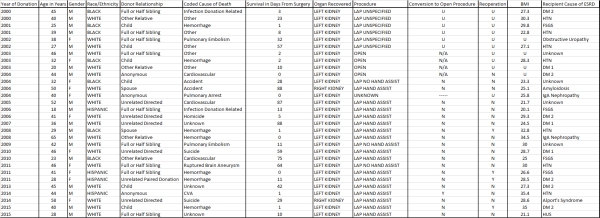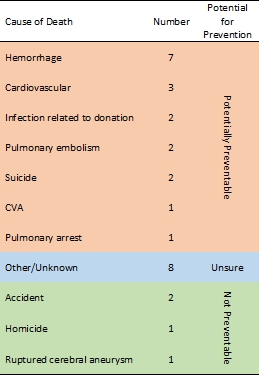Living Donor Nephrectomy: Is It as Safe as It Can Be? Analysis of Living Donor Deaths in the United States
1Medicine, Sacred Heart Hospital, Pensacola, FL
2President, Clinical Integration Solutions, LLC, Health Safety Consultancy Company, New York, NY
3Surgery, University of Florida, Gainesville, FL.
Meeting: 2018 American Transplant Congress
Abstract number: C119
Session Information
Session Name: Poster Session C: Kidney Living Donor Issues
Session Type: Poster Session
Date: Monday, June 4, 2018
Session Time: 6:00pm-7:00pm
 Presentation Time: 6:00pm-7:00pm
Presentation Time: 6:00pm-7:00pm
Location: Hall 4EF
The reported rate of death from living donor nephrectomy is 3 in 10,000 donations. Although this risk is low, the important question is how many deaths are preventable? In order to study this question, all living donor nephrectomy cases recorded in the Scientific Registry of Transplant Recipients (SRTR) database since its inception in 1987 were analyzed to determine the death rate and the number of deaths that were potentially preventable. The number of deaths at 7, 30, 90 and 365 days post donation were 16, 26, 38 and 86 which translated into 1.15, 1.87, 2.73 and 6.18 deaths per 10,000 donations respectively. From 2000 onward, when coding was available for cause of death, 19 of the 30 deaths were deemed potentially preventable.
 The non-risk adjusted rate of death with laparoscopic donation was higher than open nephrectomy, but this difference did not reach statistical significance. Conversion from laparoscopic to open nephrectomy occurs in about 1 in 100 surgeries and this rate has remained fairly steady since 2005. This analysis suggests that up to two thirds of deaths are potentially preventable. The transplant community should consider additional safety strategies such as simulation training of rare complications to lower donor risk.
The non-risk adjusted rate of death with laparoscopic donation was higher than open nephrectomy, but this difference did not reach statistical significance. Conversion from laparoscopic to open nephrectomy occurs in about 1 in 100 surgeries and this rate has remained fairly steady since 2005. This analysis suggests that up to two thirds of deaths are potentially preventable. The transplant community should consider additional safety strategies such as simulation training of rare complications to lower donor risk.
CITATION INFORMATION: Keith D., Brown J., Andreoni K. Living Donor Nephrectomy: Is It as Safe as It Can Be? Analysis of Living Donor Deaths in the United States Am J Transplant. 2017;17 (suppl 3).
To cite this abstract in AMA style:
Keith D, Brown J, Andreoni K. Living Donor Nephrectomy: Is It as Safe as It Can Be? Analysis of Living Donor Deaths in the United States [abstract]. https://atcmeetingabstracts.com/abstract/living-donor-nephrectomy-is-it-as-safe-as-it-can-be-analysis-of-living-donor-deaths-in-the-united-states/. Accessed December 14, 2025.« Back to 2018 American Transplant Congress
